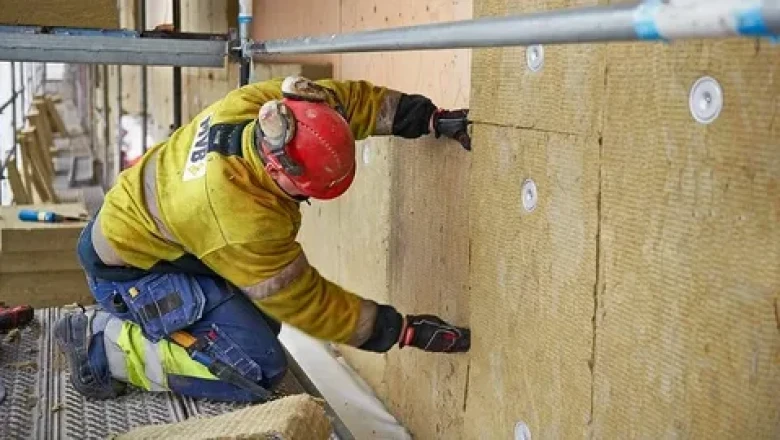views
Building Insulation Materials
Thermal insulation materials play a vital role in maintaining comfortable temperatures inside buildings. Some commonly used insulation materials and their properties are discussed below:
Fibreglass Insulation
Fibreglass insulation is one of the most widely used Building Thermal Insulation materials for buildings. It is made from very thin glass fibres, assembled into mats or batts. Fibreglass insulation has an R-value of around 3-4 per inch which means it provides good insulation against heat transfer. It is flexible, moisture-resistant and easy to install in walls and attics. The main drawback is that fibreglass can irritate skin and lungs if inhaled, so protective gear is needed during installation.
Mineral Wool Insulation
Mineral wool insulation is made from molten rock or slag and is available as batts, blankets and loose-fill materials. It has higher density compared to fibreglass but provides effective thermal and acoustic insulation. Mineral wool has an R-value of around 2.5-4 per inch. It is moisture-resistant, durable and poses minimal health hazards during installation compared to fibreglass. However, it is more expensive.
Spray Polyurethane Foam (SPF) Insulation
SPF insulation involves spraying a liquid that expands and hardens in place to form a rigid foam insulation. It adheres easily to most surfaces and fills all cracks and gaps, making it very effective for cavity walls and attics. SPF has the highest R-value of around R-6-7 per inch. Though expensive, it drastically reduces air leakage. Regular ventilation is required with SPF due to low permeability.
Cellulose Insulation
Cellulose insulation is made from 80% recycled newspaper and has a high R-value of around R-3.5 per inch. It is inexpensive and environment-friendly. Loose-fill cellulose is used to fill wall cavities, attics and other spaces. Though inexpensive, it absorbs moisture easily if not installed properly. It also tends to settle over time requiring periodic replenishing.
Factors affecting thermal insulation effectiveness
While the type of insulation material plays a major role, several other factors also influence how well it can insulate a building. Some important factors are:
Thickness
Simply put, more insulation thickness directly translates to greater insulating value. Doubling insulation thickness doubles its resistance to heat flow. Insulation should meet or exceed minimum recommended thickness for the climate.
Installation Quality
Proper installation is crucial for insulation to deliver its full rated R-value. Common installation errors like gaps, voids, compressed or wet insulation significantly impact performance. Proper sealing of all joints and edges is important.
Air Leakage
Presence of drafts or gaps allows unwanted air movement which reduces insulation ability. All potential air pathways through outside walls, attics, basements, windows and doors should be sealed effectively.
Moisture Resistance
Insulation soaked or exposed to moisture for long loses much of its insulation properties. Moisture also breeds mold, rot and other damages. Moisture-resistant insulation or vapor barriers are recommended in certain areas.
Aging and Settling
Over time, some insulation types like cellulose can settle, leaving gaps. Fibreglass also losesR-value slowly with aging. Homeowners should re-check insulation levels every few years and replenish if required.
Importance of Building Envelope Sealing
An air tight building envelope plays a vital role along with insulation in maintaining indoor climate control. Air leakage accounted for about 27% of total energy loss from a typical home according to a 2009 study by the Department of Energy. Some key elements of an effective building envelope sealing include:
Air sealing attics - Attics are among the biggest sources of air leakage. All attic bypasses and penetrations through top plates should be sealed properly.
Basement/crawlspace sealing - Cracks or gaps in walls, windows, flooring should be caulked or weatherstripped to prevent air movement.
Window and door sealing - Windows and exterior doors are major air leakage points. Proper weatherstripping, caulking and insulation is needed around frames.
Plumbing/wiring penetrations - Holes created to pass pipes, cables etc. should be sealed fire-stopped or foam-gasketed.
Independent ventilation - Insulated buildings should have properly sealed and balanced whole-house ventilation to avoid moisture buildup issues.
Blower door tests - Performing blower door tests helps identify specific air leakage sites that need sealing improvements. Contractors can offer such diagnostic services.
suitable insulating materials, enhanced thickness levels, proper installation and a well-sealed building envelope are crucial for optimizing thermal performance of buildings. This helps reduce energy costs while keeping interiors comfortable all year round. With increasing energy prices and importance of sustainability, adequate insulation should be a priority for new construction as well as existing building upgrades.
About Author:
Money Singh is a seasoned content writer with over four years of experience in the market research sector. Her expertise spans various industries, including food and beverages, biotechnology, chemical and materials, defense and aerospace, consumer goods, etc. (https://www.linkedin.com/in/money-singh-590844163)






















Comments
0 comment